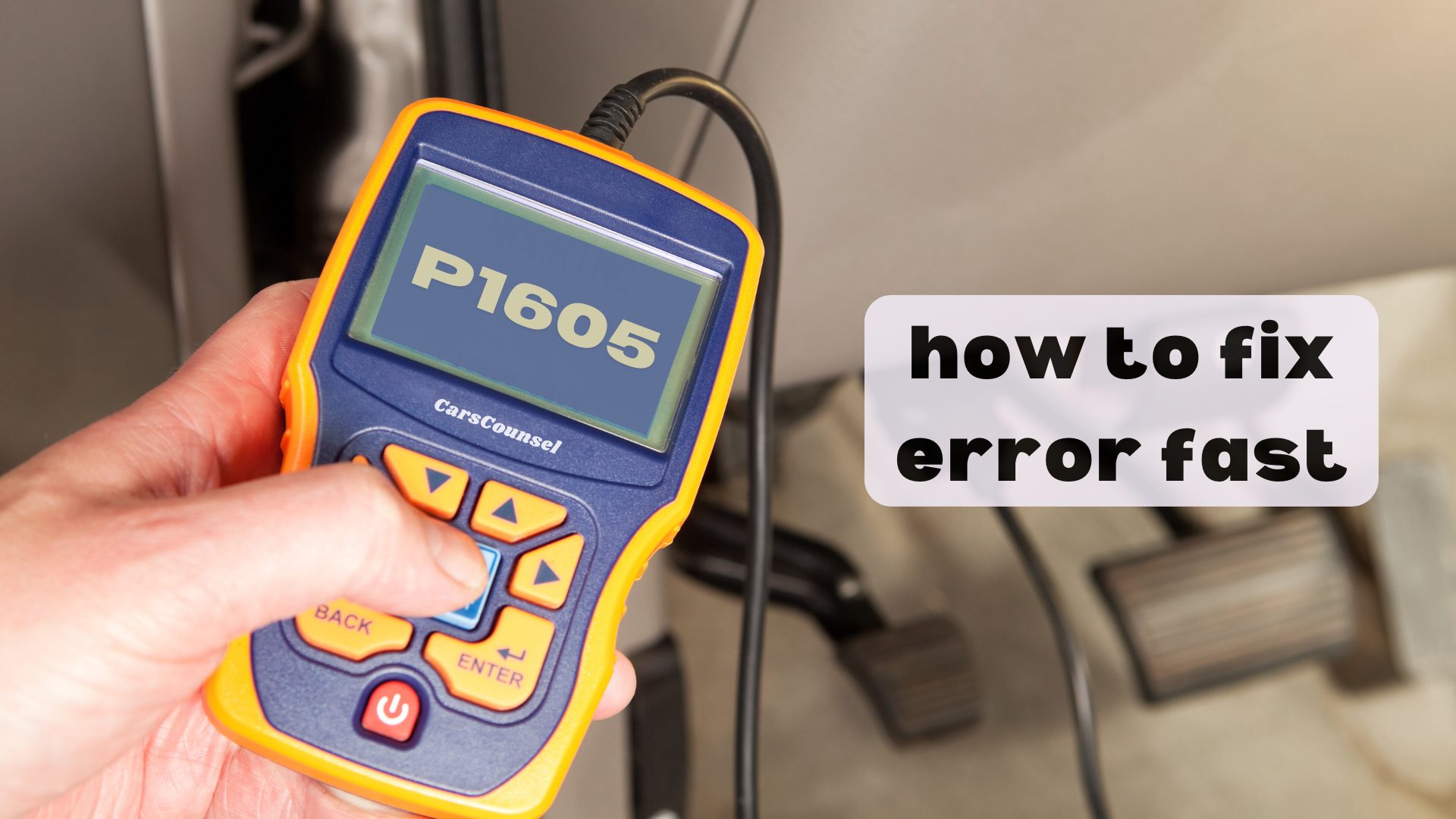You might not know this, but the P1605 code often signals a deeper problem with your car’s ECM (Engine Control Module), not just a simple error.
It’s crucial to tackle this issue quickly to avoid more OBD2 problems. Start by checking your battery voltage and inspecting the wiring.
But there’s more to it than just these first steps. Wondering what’s causing this error and how to fix it fast?
Let’s go through the process so you can get your car running smoothly again in no time.

Quick Navigation
Key Takeaways
- Check the battery voltage and terminals to make sure there’s enough power and no electrical problems.
- Look at the wiring for any damage or loose connections to find and fix any breaks that might be affecting the ECM.
- Use diagnostic tools and OBD2 scanners to check if the sensors are working right and find the exact problem.
- Check and replace the ECM if it’s faulty to get the engine running correctly again.
Understanding P1605 Code
The P1605 code means there’s a problem with the engine control module (ECM) inside your car. This can cause issues like lower performance and trouble starting the engine.
When the ECM isn’t working right, it messes with how different parts of the engine work together. You’ll probably see the check engine light come on and might have a hard time starting the car.
It’s important to diagnose this problem accurately to avoid more damage. Use tools like OBD2 scanners to read the error codes and find out exactly what’s wrong with the ECM.
Knowing the specific issue lets you fix it properly, getting your car back to running well without extra delays or costs.
Consequences of P1605
If you get a P1605 code, it can cause big problems with your engine and make it hard to start your car. This code means the engine control module (ECM) isn’t working right.
When the ECM malfunctions, it messes up the timing for fuel injection and ignition, leading to slow acceleration and poor gas mileage. Your car might also have trouble starting or not start at all, which could leave you stuck somewhere.
You might notice the engine acting strangely, like stalling or idling roughly. If you ignore this problem, it can put extra stress on other engine parts and lead to more expensive repairs.
Common Symptoms
If your car has a P1605 code, you might see the check engine light come on and have trouble starting your car. You could also notice rough idling, lower gas mileage, or even stalling.
This code can make your car perform poorly, with slower acceleration and overall reduced engine power. Your car might also go into ‘limp home’ mode, which limits its speed to prevent more damage.
These signs suggest there’s a problem with the car’s computer system. Knowing these symptoms can help you take action quickly, avoiding bigger problems and expensive repairs later on.
Primary Causes
A malfunctioning ECM is often the main reason behind the P1605 code, messing up various vehicle systems and causing performance problems. This can make your engine run poorly or even prevent your car from starting.
Electrical problems are also common causes, usually due to faulty wiring or connections that mess with the ECM’s ability to work properly. Bad sensors can also trigger this code by sending wrong signals to the ECM.
- Faulty Wiring: Messes with ECM function, causing electrical problems.
- Bad Sensors: Non-working sensors can send wrong data.
Environmental Factors
Extreme temperatures can really mess with your car’s ECM and trigger the P1605 code. When it’s too hot or too cold, the ECM can malfunction. Heat can cause it to overheat and break down, while cold can lead to condensation and short circuits.
Don’t underestimate how much the weather can affect your car’s ECM. Harsh climates can wear out the ECM’s internal parts, making it more likely to have issues.
If you live in a place with extreme weather, it’s important to regularly check and maintain your ECM and any related systems. Make sure your engine compartment has good ventilation and insulation to reduce these environmental effects and help prevent the P1605 code from showing up.
Affected Car Models
Susceptible Car Models
When dealing with how environmental factors affect your car’s Engine Control Module (ECM), it’s useful to know which car models are more likely to show the P1605 code. This knowledge can help you anticipate performance issues and sensor problems.
The most affected models are:
- Nissan Vehicles: Often have problems related to the anti-theft system and ECM.
- Toyota Corolla: Commonly faces issues with the throttle position sensor circuit.
Other car models can also experience the P1605 code, but it varies in severity. Knowing which models are more prone to this issue helps you perform better preventative maintenance and resolve sensor issues faster, ensuring your car runs smoothly.
Identifying these models can guide you to take proactive steps to reduce the risk of encountering the P1605 code.
Diagnosing P1605
To figure out what’s causing the P1605 code, start by checking the car battery to make sure it’s not weak or dead.
Then, look over all the wires for any damage or loose connections.
Use diagnostic tools to check if important sensors like the throttle position sensor and crankshaft position sensor are working properly. These tools can help you find if any sensors are faulty and causing the P1605 code.
After that, check the Engine Control Module (ECM) for any internal problems or software issues.
Use an OBD2 scanner to get detailed error codes, which will give you more information about the problem.
Battery Check
Start diagnosing your P1605 code by checking the car battery to make sure it’s not weak or dead. A bad battery can often cause this error code. Making sure your battery is in good shape is a key step in electrical maintenance.
Use a multimeter to check the voltage. A healthy battery should read about 12.6 volts when the engine is off.
- Check Battery Terminals: Make sure they’re clean and not corroded.
- Do a Load Test: This will show how the battery performs under stress.
These steps help prevent battery-related electrical problems and make it easier to accurately diagnose the P1605 code.
Wiring Inspection
To make sure everything works correctly and to figure out the P1605 code, carefully check the car’s wiring for any damage or bad connections. Start by looking at the wiring harnesses connected to the ECM. Look for any worn-out wires, rust, or loose connections that might mess up the wiring. Use a multimeter to make sure the wiring has consistent continuity. This helps ensure that all electrical connections are in good shape and working right.
| Step | Action |
|---|---|
| Visual Check | Look for physical damage or rust |
| Continuity | Use a multimeter to check wiring continuity |
| Connections | Make sure all electrical connections are secure |
A thorough wiring inspection can find problems that might cause the P1605 code, leading to a more accurate diagnosis.
Fixing P1605
After checking the wiring, the next step to fix the P1605 code is to address any problems you found. This could mean replacing the ECM, fixing faulty wiring, or replacing bad sensors.
The ECM is crucial for many functions in your car, so any issues with it can seriously affect how your vehicle runs. If you find any bad sensors, they need to be replaced right away to get things back to normal.
Here are the main steps:
- Replace the ECM: Change out the faulty ECM if it’s causing the problem.
- Fix or Replace Wiring: Repair or replace any damaged wiring that’s affecting the ECM.
These steps should fix the P1605 code and get your vehicle running smoothly again.
More OBD-II Codes
Frequently Asked Questions
Can Driving With a P1605 Code Cause Long-Term Damage to My Car?
Driving with a P1605 code can lead to long-term problems for your car. Your engine might not run as well, and you could end up causing more damage if you don’t fix the issue soon.
Are There Any Temporary Fixes for the P1605 Code Until I Can Get Professional Help?
You can try these quick fixes: disconnect your battery to reset the system and check for any obvious wiring problems. Use a diagnostic tool to scan for more codes and address any minor issues before you get professional help.
How Do I Reset the ECM After Fixing the P1605 Code?
To reset the ECM after fixing the P1605 code, you can either disconnect the battery for about 15 minutes or use a diagnostic tool to clear the error codes and reset the ECM. This will help the system recognize the repairs.
Will Clearing the P1605 Code With an OBD2 Scanner Solve the Problem Permanently?
Using an OBD2 scanner to clear the P1605 code is like putting a band-aid on a deep wound. It’s not a permanent fix; you need to address the root problems to solve the issues related to the P1605 code effectively.
Can Aftermarket Parts Cause a P1605 Code to Appear?
Yes, aftermarket parts can cause a P1605 code to show up. If the parts don’t work well with your car, they might mess up sensors or the engine control module (ECM). Always make sure the parts you use fit your car’s requirements.
Conclusion
To fix the P1605 code, start by checking the battery to make sure it’s fully charged.
Look closely at the wiring for any damage or loose connections.
Use diagnostic tools to identify any faulty sensors or problems with the ECM.
By carefully addressing these areas, you can get your vehicle running smoothly again.
So, get to work and you’ll be back on the road in no time.

